site search
online catalog
HISTORIC CIVIL WAR RELATED DOUBLE BARREL PERCUSSION SHOTGUN
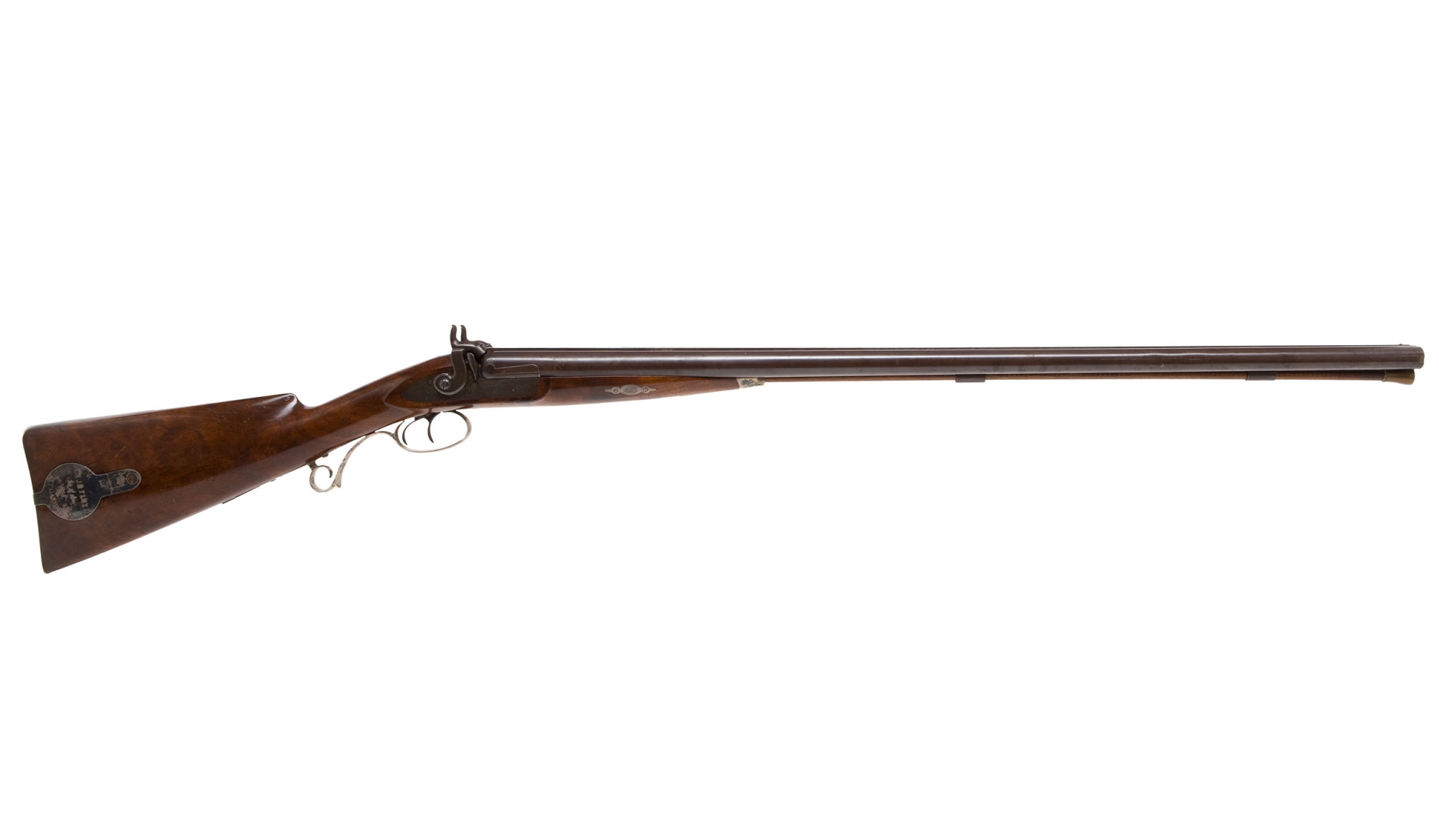
Hover to zoom

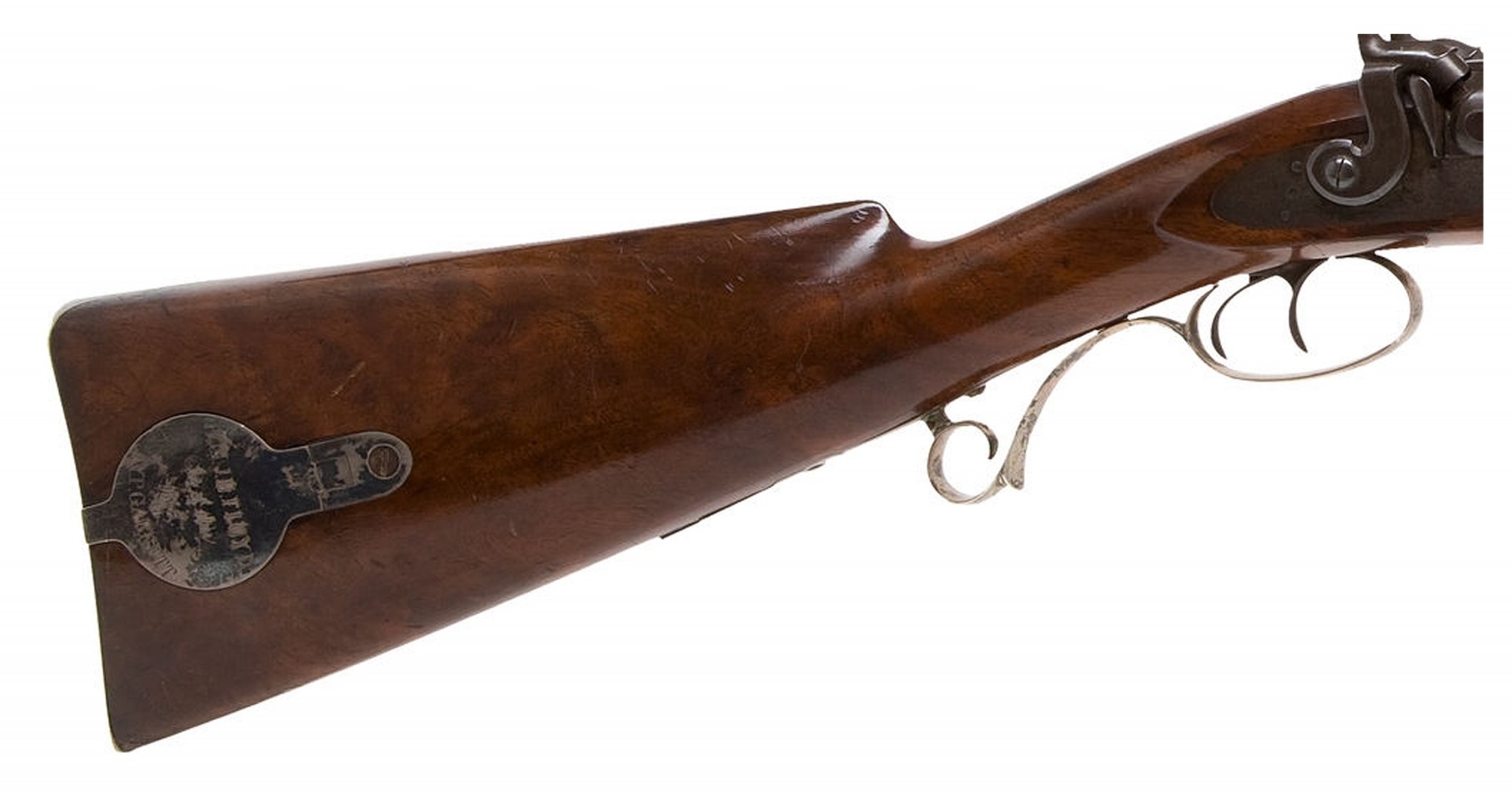
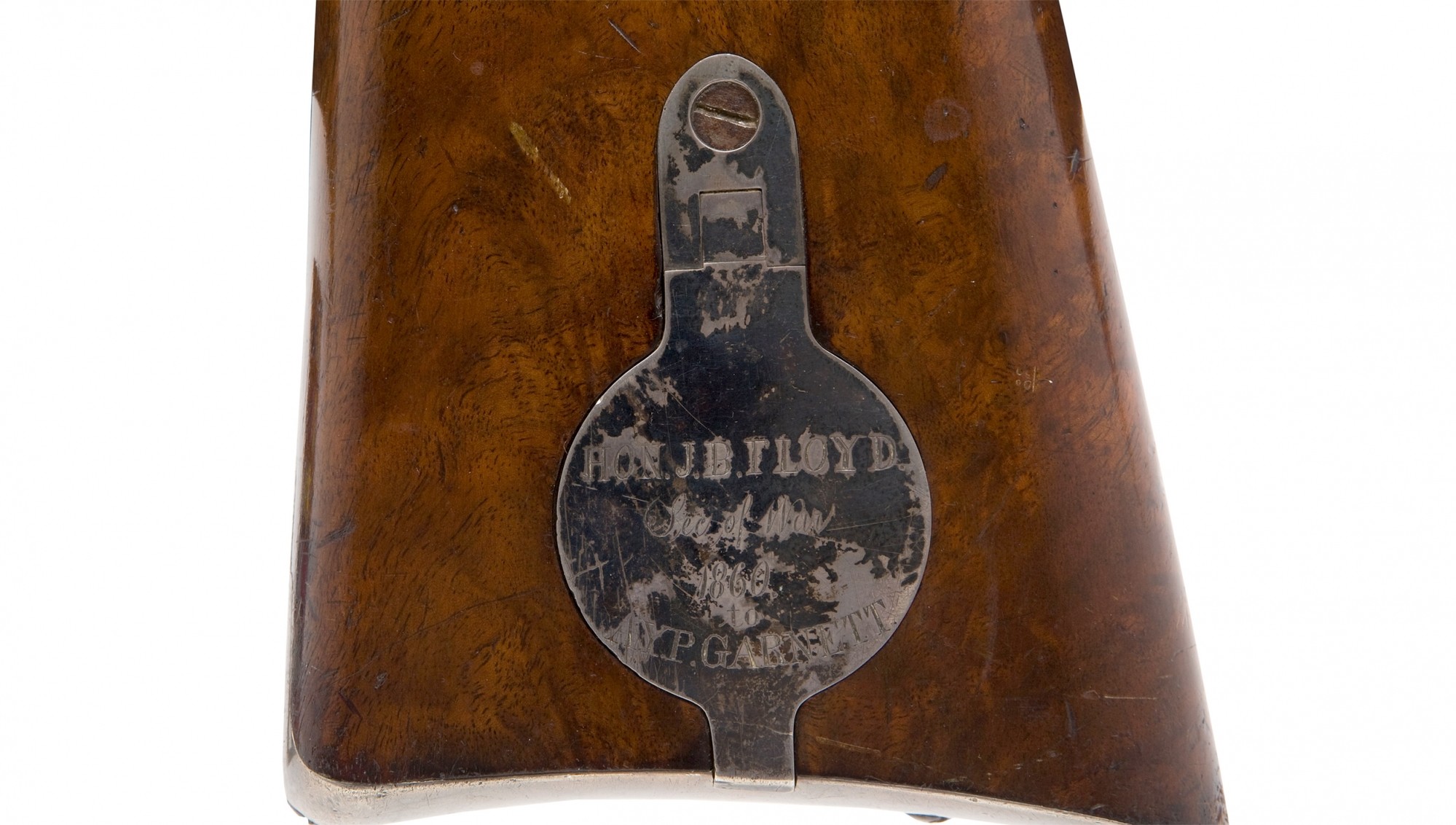
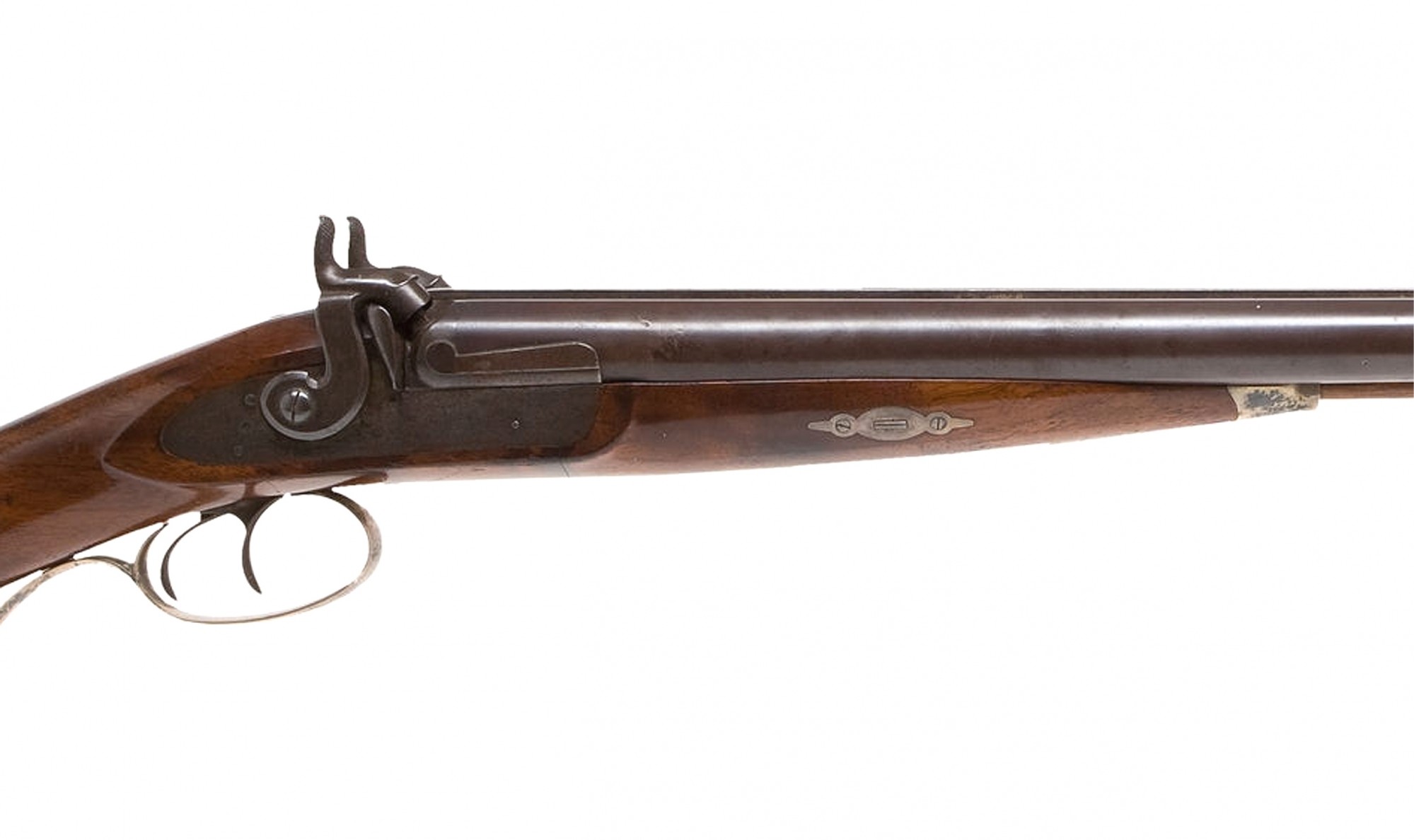
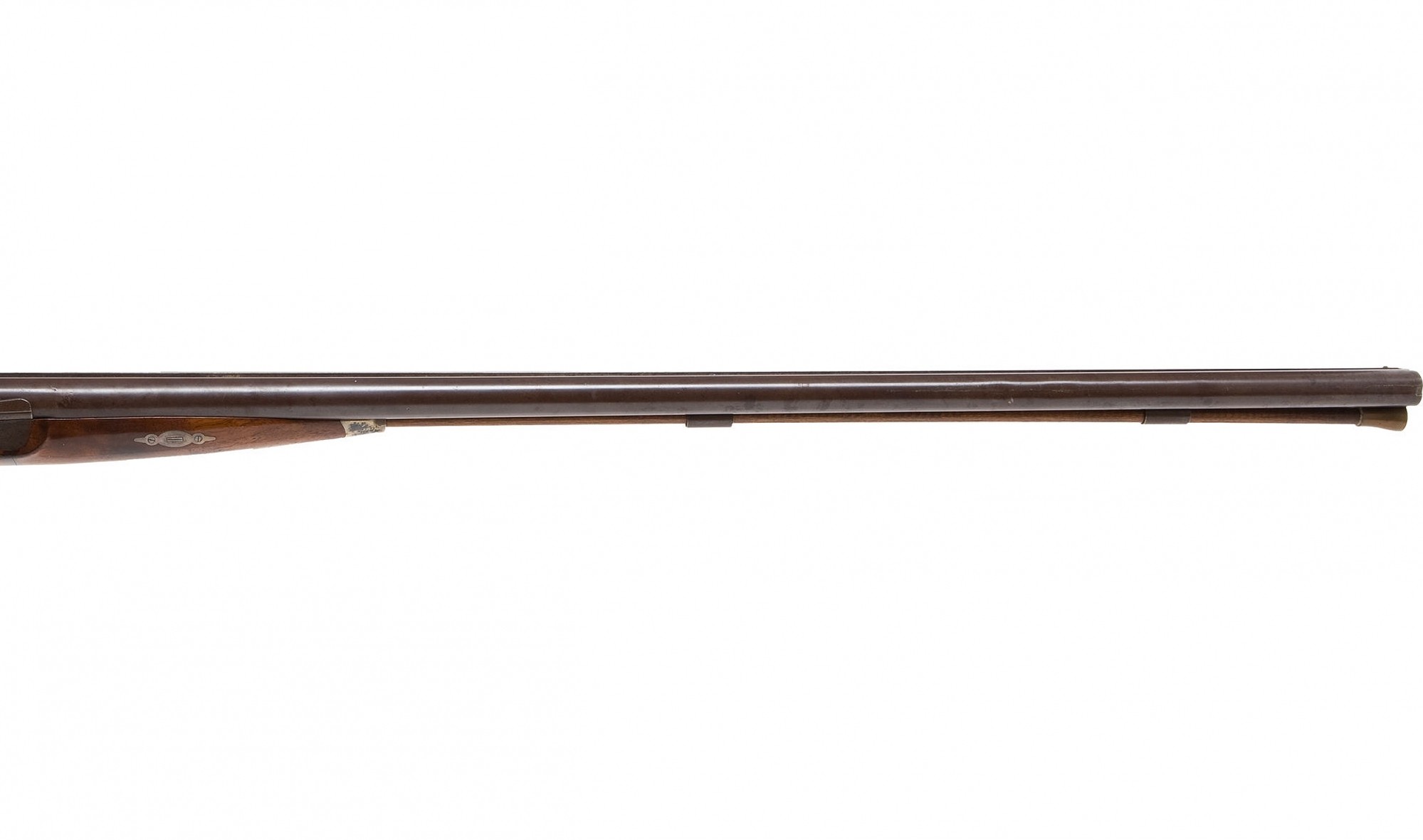
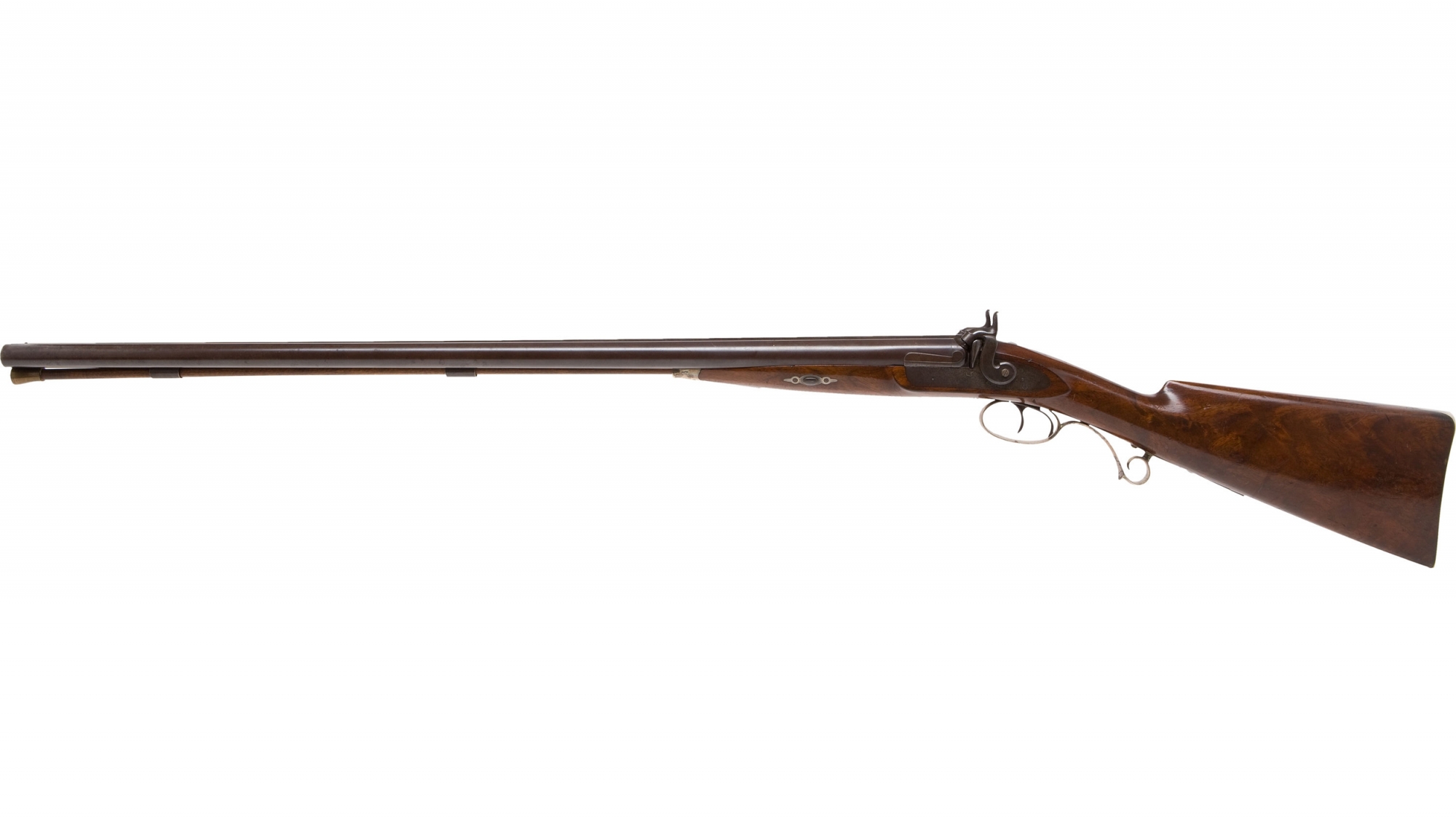
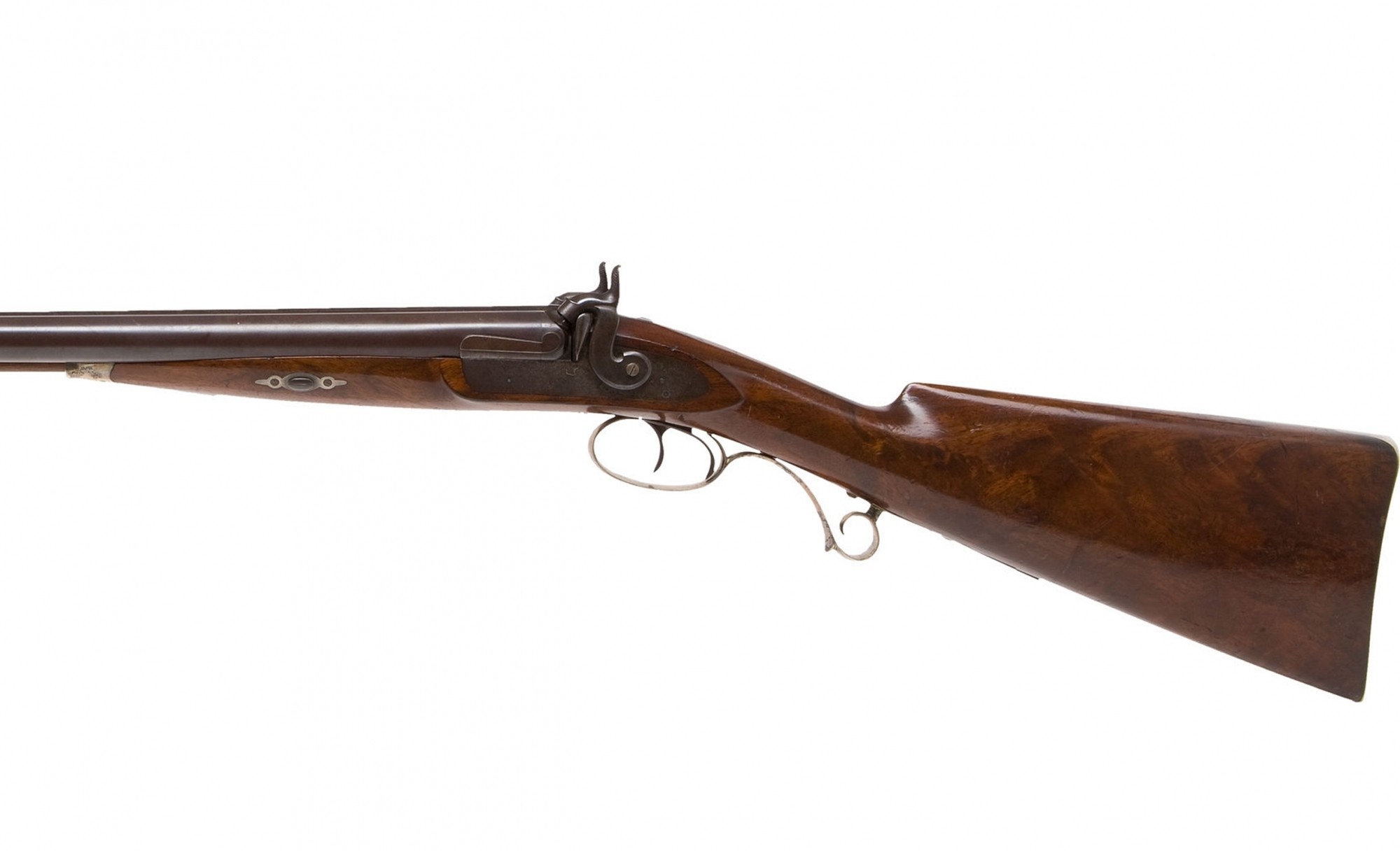
$19,500.00 SOLD
Quantity Available: None
Item Code: 344-622
"Hon. J. B. Floyd Sec. of War 1860 to A.Y.P. Garnett". This superb double-barrel percussion shotgun was presented to physician Alexander Yelverton Peyton Garnett by Secretary of War John Buchanan Floyd in 1860. At this time it's unknown what the circumstances of Floyd's gift to Garnett was, but both men were loyal Virginians and no doubt had much contact while they were in Washington prior to the outbreak of the war.
The shotgun is 10 gauge with 31½" barrels with a smooth concave rib. The barrels have a smooth dark patina mixing with much of the original blue and the brass-tipped ramrod is present. The right barrel has a shallow ¼" dent at the muzzle. The highly figured walnut stock exhibits a few minor dents and abrasions but the profile and edges are sharp and the stock appears to be untouched by repair or restoration. The mounts are heavily plated silver which retain the majority of the plating. The key escutcheons are silver. The patch box is engraved "Hon. J. B. Floyd/ Sec. of War/ 1860/ to/ A.Y.P. Garnett". The shotgun has fully functioning locks with a crisp action.
The shotgun alone is an excellent firearm, but its association with two prominent and important Southern figures makes it unique indeed. John Buchanan Floyd (1806-1863) was already a seasoned Virginia statesman when he was chosen to be James Buchanan's Secretary of War. Floyd resigned his by the President's request December 29, 1860. When Virginia seceded from the Union, Floyd was commissioned a major general in the Provisional Army of Virginia and a short time later appointed a Brigadier General in the Confederate States Army. Floyd was in command at Fort Donelson, and after its fall, he returned to Virginia retiring to his home where he died in 1863. A. Y. P. Garnett (1820-1888), was a prominent Virginia physician who remained in Richmond throughout the war and became the attending physician to the families of Robert E. Lee, and Confederate generals Joe Johnson, Wade Hampton, William Preston, and John C. Breckinridge.
Further research may unlock the circumstances of Floyd's gift to Garnett, but in the meantime it remains an exceptionally historic firearm with a story yet to be fully told.
----------------------------------------------------------------------------------------------------------------
John Buchanan Floyd was born at Smithfield estate, Blacksburg, Virginia. He was the son of John Floyd (1783–1837), who served as a representative in Congress from 1817 to 1829 and Governor of Virginia from 1830 to 1834.
After graduating from South Carolina College in 1826 (by some accounts 1829), Floyd practiced law in his native state and at Helena, Arkansas, where he lost a large fortune and his health in a cotton-planting venture. In 1839, he returned to Virginia and settled in Washington County, which he represented in the Virginia House of Delegates in 1847–49 and again in 1853. From 1849 to 1852, he was Governor of Virginia.[1] As Governor, he recommended to the legislature the enactment of a law laying an import tax on the products of states that refused to surrender fugitive slaves owned by Virginia masters.
In March 1857, Floyd became Secretary of War in the cabinet of President James Buchanan, where his lack of administrative ability was soon apparent, including the poor execution of the Utah Expedition. In December 1860, on ascertaining that Floyd had honored heavy drafts made by government contractors in anticipation of their earnings, the president requested his resignation. Several days later Floyd was indicted for malversation in office, although the indictment was overruled in 1861 on technical grounds. There is no proof that he profited by these irregular transactions; in fact, he went out of the office financially embarrassed.
Although he had openly opposed secession before the election of Abraham Lincoln, his conduct after the election, especially after his breach with Buchanan, fell under suspicion, and he was accused in the press of having sent large stores of government arms to Federal arsenals in the South in the anticipation of the Civil War. After his resignation, a congressional commission in the summer and fall of 1861 investigated Floyd's actions as Secretary of War. All of his records of orders and shipments of arms from 1859 to 1860 were examined. It is recorded that in response to John Brown's raid on Harper's Ferry he bolstered the Federal arsenals in some Southern states by over 115,000 muskets and rifles in late 1859. He also ordered heavy ordnance to be shipped to the Federal forts in Galveston Harbor, Texas, and the new fort on Ship Island off the coast of Mississippi.[2] In the last days of his term, he apparently had an intention to send these heavy guns, but his orders were revoked by the president. During the year 1860, the Southern states actually received less than their full quota of arms and the heavy guns were a normal shipment required to complete the construction of Federal forts.[citation needed] His resignation as Secretary of War, on December 29, 1860, was precipitated by the refusal of Buchanan to order Major Robert Anderson to abandon Fort Sumter, which eventually led to the start of the war. On January 27, 1861, he was indicted by the District of Columbia grand jury for conspiracy and fraud. Floyd appeared in criminal court in Washington, D.C., on March 7, 1861, to answer the charges against him. According to Harper's Weekly, the indictments were thrown out.
After the secession of Virginia, Floyd was commissioned a major general in the Provisional Army of Virginia, but on May 23, 1861, he was appointed a brigadier general in the Confederate States Army. He was first employed in some unsuccessful operations in the Kanawha Valley of western Virginia under Robert E. Lee, where he was wounded in the arm at the Battle of Carnifex Ferry on September 10. In January 1862, he was dispatched to the Western Theater to report to General Albert Sidney Johnston and was given command of a division. Johnston sent Floyd to reinforce Fort Donelson and assume command of the post there. Floyd assumed command of Fort Donelson on February 13 just two days after the Union army had arrived at that spot, also becoming the third post commander within a week.
Fort Donelson protected the crucial Cumberland River and, indirectly, the manufacturing city of Nashville and Confederate control of Middle Tennessee. It was the companion to Fort Henry on the nearby Tennessee River, which, on February 6, 1862, was captured by Union Army Brig. Gen. Ulysses S. Grant and river gunboats. Floyd was not an appropriate choice to defend such a vital point, having political influence, but virtually no military experience. General Johnston had other experienced, more senior, generals (P.G.T. Beauregard and William J. Hardee) available and made a serious error in selecting Floyd. Floyd had little military influence on the Battle of Fort Donelson itself, deferring to his more experienced subordinates, Brig. Gens. Gideon J. Pillow and Simon Bolivar Buckner. As the Union forces surrounded the fort and the town of Dover, the Confederates launched an assault on February 15 in an attempt to open an escape route. Although successful at first, indecision on General Pillow's part left the Confederates in their trenches, facing growing reinforcements for Grant.
Early in the morning of February 16, at a council of war, the generals and field officers decided to surrender their army. Floyd, concerned that he would be arrested for treason if captured by the Union Army, turned his command over to Pillow, who immediately turned it over to Buckner. Col. N. B. Forest and his entire Tennessee Cavalry Regiment escaped. Pillow escaped on a small boat across the Cumberland and the next morning Floyd escaped by steamboat with the 20th Mississippi Regiment, the 51st, 56th, 36th, and 50th Virginia regiments, and two Virginia batteries from his old Virginia command, just before Buckner surrendered to Grant, one of the great strategic defeats of the Civil War. A short time before daylight the two steamboats arrived. Without loss of time the general (Floyd) hastened to the river, embarked with his Virginians, and at an early hour cast loose from the shore, and in good time, and safely, he reached Nashville. He never satisfactorily explained upon what principles he appropriated all the transportation on to the use of his particular command".[3] Floyd was relieved of his command by Confederate President Jefferson Davis, without a court of inquiry, on March 11, 1862. He resumed his commission as a major general of Virginia Militia, but his health soon failed and he died a year later at Abingdon, Virginia, where he is buried in Sinking Spring Cemetery.
-------------------------
Alexander Yelverton Peyton Garnett (September 8, 1820 – July 11, 1888) was born in Essex County, Virginia on September 8, 1820, the son of Muscoe Garnett and Maria Battile. Among his ancestry were many of the best known old families of Virginia. His boyhood was spent at his home, and his education conducted under private tutors. He began studying medicine at the University of Pennsylvania at the age of nineteen, and graduated in 1842. After graduation, he was appointed Assistant Surgeon in the Navy. His first cruise was to the Pacific, under Commodore Cornelius Stribling, on the American steamer USS Cyane. On a subsequent cruise to South America, he met his wife, Mary Wise, daughter of then United States Minister to the Court of Brazil, Henry A. Wise. After his marriage he was stationed temporarily at Washington, but later resigned his position in the Navy and began his career as a civilian physician. He was then elected to the chair of Theory and Practice of Medicine in the National Medical College of Columbian University.
At the outbreak of the American Civil War his sympathies were warmly enlisted with his native state of Virginia; he left Washington for Richmond, Virginia, where he remained until the close of the war. So many of his friends and former patients were in this city that he very soon found himself actively engaged in as large a practice as before his removal. He was appointed surgeon in the Confederate Army, and placed in charge of two hospitals. He was also a member of the Board of Medical Examiners to examine applicants for admission to the Medical Corps. These positions he continued to hold during the entire war. He was the physician of General Robert E. Lee and family, as well as to the families of Generals Joe Johnston, Wade Hampton, William Preston, John C. Breckinridge, and of many members of the Confederate Cabinet and Congress.[3]
At the termination of the war in 1865, when Richmond was evacuated, Dr. Garnett, at the request of Jefferson Davis, accompanied him as a member of his personal staff, but after the surrender of Johnston's army he returned to Richmond a paroled prisoner. He resumed the practice of his profession in Richmond, but in 1865 returned to Washington. Here he immediately found himself engaged in active practice and in lecturing. He was elected to the chair of Clinical Medicine in the Medical Department of Columbian University, which position he held for many years. He also became one of the Board of Directors of the Children's Hospital, and served as President of the Medical Society and of the Medical Association of the District of Columbia. In 1874 he was chosen President of the Southern Memorial Association of Washington, and selected to deliver the oration upon the occasion of the interring of the dead of Early's army, who had fallen in the attack upon Washington. His address upon that occasion was conciliatory in its tone.[4]
Dr. Garnett was elected President of the American Medical Association, and presided at its meeting in 1886. His address on medical education excited a great deal of notice and approval at the time, as he brought into very broad relief the evils of medical education in this country. His last public work was in connection with the meeting of the International Medical Congress, held in Washington in 1887. It is well known how many obstacles and difficulties attended the completing of the arrangements for that meeting and it was only by dint of most arduous labor and untiring energy that Dr. Garnett, as Chairman of the Committee of Arrangements, gave it so large a measure of success. There is no doubt that the anxiety of mind and physical fatigue attendant upon his duties at this time helped to bring on the death of Dr. A. Y. P. Garnett, a failure of health which ended in his sudden death in the summer of 1888.
Dr. Garnett contributed a number of papers to medical journals, which were all of great practical value and interest. The paper which he read at the meeting of this Society, in 1887, entitled "Observations on the Sanitary Advantages of Tide Water Virginia" is a fair example of his thoroughness in the treatment of medical questions.
DISCLAIMER: All firearms are sold as collector's items only - we do not accept responsibility as to the shooting safety or reliability of any antique firearm. All firearms are described as accurately as possible, given the restraints of a catalog listing length. We want satisfied customers & often "under" describe the weapons. Any city or state regulations regarding owning antique firearms are the responsibility of the purchaser. All firearms are "mechanically perfect" unless noted, but again, are NOT warranted as safe to fire!
Inquire About HISTORIC CIVIL WAR RELATED DOUBLE BARREL PERCUSSION SHOTGUN
Most Popular
Historical Firearms Stolen From The National Civil War Museum In Harrisburg, Pa »
Theft From Gravesite Of Gen. John Reynolds »
Selection Of Unframed Prints By Don Troiani »
Fine Condition Brass Infantry Bugle Insignia »
Large English Bowie Knife With Sheath 1870’S – 1880’S »
Imported (Clauberg) Us Model 1860 Light Cavalry Officer's Saber »
featured item
VERY RARE VIRGINIA OFFICER’S HAT INSIGNIA
This is a really great, and really rare piece of insignia, showing its age in the natural oxidation of the black velvet ground to soft brown and the embroidered bullion wreath and “VA” to a muted silver-gray, but with no moth holes, just a few… (1299-29). Learn More »


